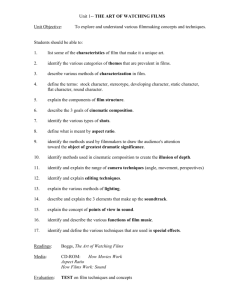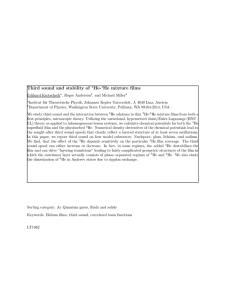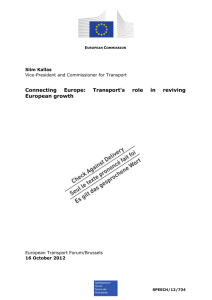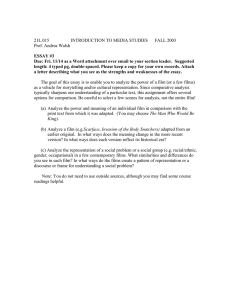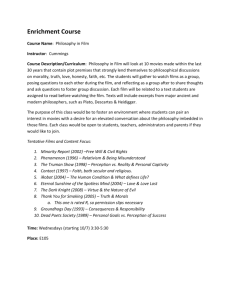SOC’s Center for Environmental Filmmaking
advertisement
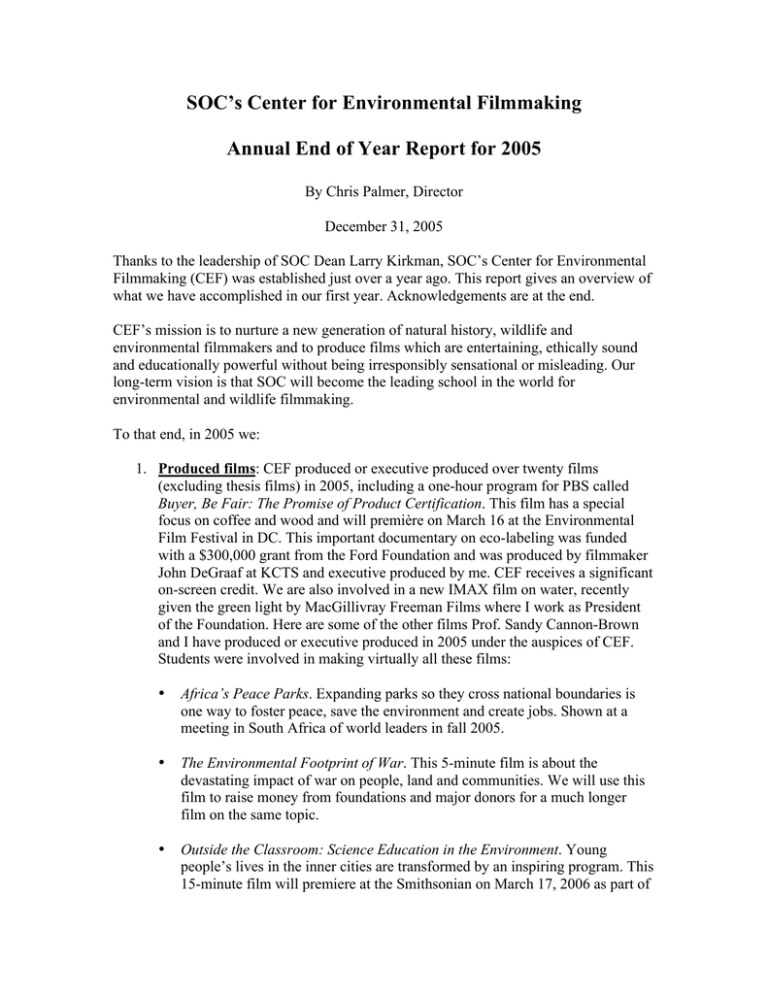
SOC’s Center for Environmental Filmmaking Annual End of Year Report for 2005 By Chris Palmer, Director December 31, 2005 Thanks to the leadership of SOC Dean Larry Kirkman, SOC’s Center for Environmental Filmmaking (CEF) was established just over a year ago. This report gives an overview of what we have accomplished in our first year. Acknowledgements are at the end. CEF’s mission is to nurture a new generation of natural history, wildlife and environmental filmmakers and to produce films which are entertaining, ethically sound and educationally powerful without being irresponsibly sensational or misleading. Our long-term vision is that SOC will become the leading school in the world for environmental and wildlife filmmaking. To that end, in 2005 we: 1. Produced films: CEF produced or executive produced over twenty films (excluding thesis films) in 2005, including a one-hour program for PBS called Buyer, Be Fair: The Promise of Product Certification. This film has a special focus on coffee and wood and will première on March 16 at the Environmental Film Festival in DC. This important documentary on eco-labeling was funded with a $300,000 grant from the Ford Foundation and was produced by filmmaker John DeGraaf at KCTS and executive produced by me. CEF receives a significant on-screen credit. We are also involved in a new IMAX film on water, recently given the green light by MacGillivray Freeman Films where I work as President of the Foundation. Here are some of the other films Prof. Sandy Cannon-Brown and I have produced or executive produced in 2005 under the auspices of CEF. Students were involved in making virtually all these films: • Africa’s Peace Parks. Expanding parks so they cross national boundaries is one way to foster peace, save the environment and create jobs. Shown at a meeting in South Africa of world leaders in fall 2005. • The Environmental Footprint of War. This 5-minute film is about the devastating impact of war on people, land and communities. We will use this film to raise money from foundations and major donors for a much longer film on the same topic. • Outside the Classroom: Science Education in the Environment. Young people’s lives in the inner cities are transformed by an inspiring program. This 15-minute film will premiere at the Smithsonian on March 17, 2006 as part of 2 the Environmental Film Festival in DC. We are also producing a companion music video. • Speaking for the Mute. Mute swans were wrongly slaughtered on the Chesapeake Bay this summer. This 7-minute film makes the case for why the slaughter was an immoral act. This film was used extensively on The Humane Society of the United States web site as its top item. • The Only Water We Will Ever Have. This 6-minute film for children is about the value of water and how we should not waste or pollute it. It was made for the National Park Service and NPS is using the film in their school programs and is showing it in Great Falls National Park. • Neighborhood Nest Watch. This 5-minute film shows how Smithsonian scientists are using observations about birds to tell them and the public about what is happening to our environment. It was made for the Smithsonian Environmental Research Center and they will use the films in their programs. • Careers Working with Animals. Six SOC students worked under the auspices of CEF and HSUS to produce 12 short films on people who have created successful and satisfying careers related to animals. These films were produced for Humane Society University and are now being used in the University’s curriculum. 2. Developed partnerships: In order to create internship opportunities for students and to develop opportunities for students to make films, CEF developed partnerships with the National Oceanic and Atmospheric Administration, the federal government’s Mineral Management Service, The Humane Society of the United States, Filmmakers For Conservation, EarthEcho International and the National Park Service. 3. Created jobs and internships for SOC students: In 2005, CEF created jobs (most of them paid) for over 15 SOC students on CEF films. 4. Organized and hosted monthly events in the Wechsler Theater: CEF and Filmmakers for Conservation joined forces to sponsor and organize monthly events in Wechsler which drew large audiences. Topics included filmmaking in Central Africa with film producer Cynthia Moses, war and the environment with Holly Stadtler, rescuing animals hurt by Hurricane Katrina with Emil Gallina, and student films. We have monthly meetings planned throughout 2006 in the Wechsler Theater. 5. Raised money: We worked with Cathy Barton and Liz Kirby in the Office of Sponsored Programs, as well as Larry Kirkman and Anne Menotti, to raise money for CEF. While we had success (we received over a dozen gifts and grants) we 3 intend to intensify our fund-raising efforts in 2006. We are cultivating a large number of prospects. 6. Created new programs: Working with Susan Gutenberg, CEF created Classroom in the Wild (co-taught by Sandy Cannon-Brown and me) as a new intensive four week summer program (COMM-570.N05) at SOC. Ten students produced three successful short films for blue chip clients (Smithsonian, HSUS and NPS). We have also created a one-week spring break filmmaking class in the wilds of Florida with filmmaker Wolfgang Obst from March 11-17, 2006. 7. Taught classes: Besides Classroom in the Wild, I taught COMM-596-007 (Producing Environmental and Wildlife Films), COMM-516-001 (Producing Environmental and Wildlife Films) and COMM-550-001 (Financing and Marketing Independent Productions), all of which have gone very well. (COMM550-001 is part of Randall Blair’s Weekend Film & Video Production program and I am proud to be a member of his faculty.) I also contributed over fifteen guest lectures and presentations to other SOC classes, and advised half a dozen graduate students on their thesis films. 8. Created events and programs at film festivals and conferences: CEF created dozens of events and programs, all promoting the CEF mission, at festivals and conferences nationwide, including RealScreen in DC, the Environmental Film Festival in DC, Wildscreen in Bristol in the UK, the International Wildlife Film Festival in Missoula, MT, the Jackson Hole Wildlife Film Festival in Jackson Hole, WY, and the Giant Screen Cinema Association (IMAX) conference in Boston. CEF and EarthEcho International created a Student Environmental Film mini-Festival which will be held at the upcoming Environmental Film Festival in DC on March 16-24. We are also working with the Center for Social Media to create and organize six significant events at SOC this coming March as part of the Environmental Film Festival. 9. Gave over 25 keynote speeches: Attached is a list of some of the keynote speeches I gave this year at various film festivals and conferences around the country. 10. Funded awards: CEF funded awards (for example, at SOC’s Visions Festival), gave small funding grants for thesis films, and funded film festival events. We also created the Mavis and Sidney John Palmer $50,000 endowed Scholarship in honor of my parents. 11. Contributed to student-led projects: CEF contributed to student-led projects, such as SOC grad student Michelle Williams’s idea to create a new AU student film organization focused on bringing about social action. CEF also supported the student-led American TV (ATV) on campus. 4 12. Designed a CEF web site: Thanks to Jane Wilson, Eddie Sherman, Lisa Bream, Wes Schauble, Brad Boeke and Marissa Schneider, we have almost finished creating a CEF web site. It will an integral member of the SOC family of web sites and will be launched in early 2006. 13. Grew CEF by adding outstanding new faculty members: Thanks to Dean Kirkman, CEF became stronger in the second half of 2005 when the Dean hired renowned filmmakers Larry Engel and Maggie Burnette Stogner on to the SOC faculty. Both Larry and Maggie bring to SOC and CEF enormous and awardwinning natural history filmmaking experience. 14. Developed partnerships with other parts of AU: For example, CEF developed strong ties to the Environmental Studies Program in CAS (Professors Cathy Schaeff, Kiho Kim and Karen Bushaw-Newton). Already two of their students have taken my class Producing Environmental and Wildlife Films. We are planning several programs together, including (thanks to Ivy Broder) launching a science/film class in the British Virgin Islands. We had some disappointments in 2005, such as a film on the excessive drilling for oil and gas in Wyoming not working out. But overall it was a good first year for CEF. Acknowledgements I am grateful for the support, help and encouragement CEF has received from Dean Larry Kirkman, Division Director Prof. John Douglass, Associate Dean Rodger Streitmatter, Assistant Dean Rose Ann Robertson and many other members of the SOC faculty. CEF also receives valuable assistance from Assistant Dean Patrick Martin, Assistant Dean Merry Mendelson and their staffs. Also deserving special mention are the following SOC staff: Brad Boeke, Michon Boston, PJ Brennan, Marc Cicero, Eric Faust, Bettina Fisher, Glenn Luther, Anne Menotti, Kristi Plahn-Gjersvold, Margaret Powell, Wes Schauble, Ali Shirazi, Geoff Turner, Sean White and Jane Wilson. CEF could not survive without their support, diligence and caring. I also want to thank my faculty colleagues who work directly with me on CEF programs, specifically adjunct Prof. Sandy Cannon-Brown, Prof. Larry Engel, Prof. Maggie Burnette Stogner and adjunct Prof. Holly Stadtler. CEF Annual End of Year Report to the Dean Dec 2005
